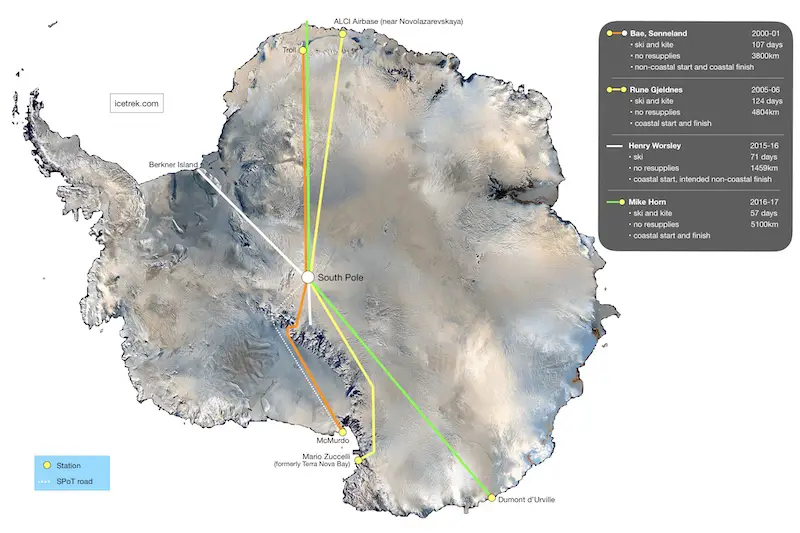Over the course of the Antarctic expedition season two of the skiers that we followed closely were American Colin O’Brady and Brit Lou Rudd. As you probably already know, those are the two men who were individually attempting to make the first solo, unsupported, and unassisted traverse of the frozen continent. In late December, both men seemed to accomplish their goals, with O’Brady finishing first and Rudd arriving at the Ross Ice Shelf two days later. Their feats were heralded across the globe, making headlines in mainstream media and more traditional adventure outlets alike. But not long after the arrival of the New Year, questions began to arise over some of their claims, calling into question the definitions for “unsupported” and “unassisted” when pertaining to these types of expeditions. Now, in an effort to help readers understand this issue more fully, Explorers Web has taken a deep dive into this murky situation in an attempt to provide context and precedent.
In an article entitled “Crossing Antarctica: How the Confusion Began and Where Do We Go From Here,” polar expedition veteran and historian Damien Gildea takes readers through the history of expeditions to the Antarctic, starting in its earliest days and running through O’Brady and Rudd’s recent journeys. He also looks at how a traverse was initially defined when Scott, Amundsen, and Shackleton were exploring the continent and how that definition shifted over time. The story takes a long look at a number of important expeditions as well, including Reinhold Messner and Arved Fuchs’s historic crossing on skis, as well as the epic journey of Borge Ousland that remains the true standard by which all others are measured.
What’s at stake here is defining when a true “first” has been accomplished not just in the Antarctic, but other remote and challenging areas around the world. In this case, O’Brady claims the first unassisted, unsupported, solo traverse of the continent, but in doing so he left out some large chunks of ice that have been included in any traverse attempts in the past. Rudd followed the same course, with both men leaving the Ronne Ice Shelf and Ross Ice Shelf off of their routes completely. Historically speaking, those two major sections of ice were included as being part of the continent and therefore needed to be skied across to claim a full-distance traverse.
The other major factor that has raised controversy is the fact that both men also used a groomed road to help them ski the final section of their expeditions. The road is smooth, easy to ski on, and has navigational flags at predetermined increments that eliminate the need to use a map and compass to find your way. This not only allowed O’Brady and Rudd to finish much faster than expected, but it has raised questions with the expedition community as to what defines “support” on a journey as this one. Most feel the road definitely constitutes support, which would nullify some of the claims by the two skiers.
The ExWeb article takes a look at all of these elements and much more. If you’re not already tired of hearing about this controversy, I’d definitely urge you to give it a read. It is highly educational for those of us who follow these types of expeditions. You can find the entire story here.
- Gear Review: The Xero Scrambler Mid is an Ultralight Hiking Shoe for Spring - March 1, 2023
- Gear Review: Yeti Roadie 48 Wheeled Cooler - August 18, 2022
- Kristin Harila Continues Pursuit of 8000-Meter Speed Record - August 16, 2022

Even Messner has lifted quite a stink about it here in Italy.
Here is an article in Gazzetta dello Sport, Italy’s main sport newspaper: http://alpinistiemontagne.gazzetta.it/2019/01/07/messner-interviene-sulla-traversata-dellantartide/
I understand the need to balance between “marketing” and “rules of adventure”… But it also feels like we are missing out on a bit of “wonder”.